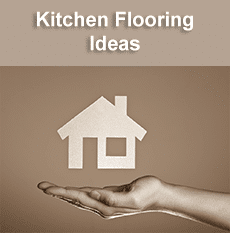 Kitchen flooring used to be a simple choice: linoleum or tiles. Now you have a much wider choice of flooring materials for your kitchen. The choice you make can make a difference to the value of your home, particularly if you intend selling in the near future. Here are some ideas for materials suitable for your kitchen floor.
Kitchen flooring used to be a simple choice: linoleum or tiles. Now you have a much wider choice of flooring materials for your kitchen. The choice you make can make a difference to the value of your home, particularly if you intend selling in the near future. Here are some ideas for materials suitable for your kitchen floor.
Kitchen Flooring Ideas: Wood
Wooden floors are popular in many homes, and are frequently enhanced by the use of area or accent rugs. However, rugs are not recommended for use in kitchens for hygiene and safety reasons. Nevertheless, many still prefer large expanses of solid wood flooring to any other floor covering. It is particularly popular in homes where the kitchen and living areas share an open plan design.
Hardwood floors look good when finished with wax or oil to provide a glowing but waterproof finish – though not ideal for kitchen flooring. Such finishes require regular cleaning and treatment to maintain the finish. A more durable surface for kitchen flooring can be obtained by using a polyurethane varnish on the wood. PU cures to a very hard and resilient surface that is easily cleaned.
The type of wood flooring available today is more durable than the old style boards of the past. Harwood blocks coated with PU varnish will last 5-6 years before needing another coat of varnish. The surface can be kept clean with an ordinary floor mop and is resistant to everyday spills, oils, hot fats and most other kitchen spillages. Popular hardwoods include cherry, maple, oak and hickory – the latter being particularly hardwearing.
Cork Flooring for Kitchens
Cork might appear to be an unlikely material for a kitchen floor, but it is preferred by a lot of people. Cork is warm to the touch, and great if you like walking barefoot in your home. It can be finished in a number of colors and varnishes. It is also a very handy surface if you drop a glass or valuable plate.
Many believe that cork would easily be dented, but nothing is further from the truth. Unlike wood, where a dent is permanent, cork quickly reverts to its original smoothness when deformed. It is also extremely resistant to water spillages.
Brick and Ceramic Tiles
Many people love using ceramic tiles in their kitchen. These are not like the small glazed tiles you would use in a bathroom. Kitchen tiles are larger and specifically designed to be anti-slip. They are available in a wide selection of patterns and colors and are easy to mop. Ceramic kitchen tiles are beautiful and add a touch of class and a Mediterranean look to your kitchen.
An alternative to regular ceramics is brick. Rather than use standard building bricks, kitchen bricks are a thinner version that have the durability and look of aged brick and easy to lay. If you like the idea of a brick floor in your kitchen, pavers are available in a wide range of finishes and shades. They are very durable, almost indestructible and very easy to wash clean. Perfect for a ceramic kitchen floor!
Rubber Kitchen Flooring
Professional chefs have been using rubber kitchen flooring for many years. It helps reduce breakages to a minimum, is warm to walk on and is very easy to keep clean. It is also a very easy surface on the feet and legs which is why the pros like it. Even though they are made from recycled tires, rubber flooring is available in a huge choice of colors. You can buy them like vinyl – in tile form or in rolls for easy laying over large areas.
These are just some of the alternative forms of kitchen flooring that are available today. We have still to mention concrete, bamboo and vinyl, but if you choose any of those above you are sure to have fabulous kitchen flooring that is easy to keep clean and is very durable. Most are available in colors and designs to suit any kitchen and will certainly help your home to improve in value over the years and maintain your home equity.


About The Author: Karengustin
More posts by karengustin